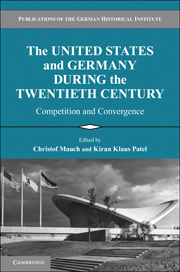Book contents
- Frontmatter
- Contents
- Contributors
- Acknowledgments
- 1 Modernities: Competition versus Convergence
- 2 Empires: Might and Myopia
- 3 Religion: Belief and Power
- 4 Law: Constitutionalism and Culture
- 5 Welfare: Entitlement and Exclusion
- 6 Immigration: Myth versus Struggles
- 7 Masses: Mobilization versus Manipulation
- 8 Market: Consumption and Commerce
- 9 Authority: Schools and Military
- 10 Gender: Equality and Differences
- 11 Environment: Conservation versus Exploitation
- 12 Film and Television
- 13 Education: Universities and Research
- 14 Media: Government versus Market
- Index
6 - Immigration: Myth versus Struggles
Published online by Cambridge University Press: 12 October 2018
- Frontmatter
- Contents
- Contributors
- Acknowledgments
- 1 Modernities: Competition versus Convergence
- 2 Empires: Might and Myopia
- 3 Religion: Belief and Power
- 4 Law: Constitutionalism and Culture
- 5 Welfare: Entitlement and Exclusion
- 6 Immigration: Myth versus Struggles
- 7 Masses: Mobilization versus Manipulation
- 8 Market: Consumption and Commerce
- 9 Authority: Schools and Military
- 10 Gender: Equality and Differences
- 11 Environment: Conservation versus Exploitation
- 12 Film and Television
- 13 Education: Universities and Research
- 14 Media: Government versus Market
- Index
Summary
The most potent symbols of American immigration are the Statue of Liberty and Emma Lazarus's illustrious poem, “The New Colossus.” Embossed on a bronze plaque affixed to the statue's pedestal in the early 1900s, the poem reads, “‘Keep ancient lands your storied pomp!’ Cries she, with silent lips. ‘Give me your tired, your poor, your huddled masses yearning to breathe free…. ‘” This poem was written during a time of unprecedented immigration to the United States. Between 1900 and the start ofWorldWar I, approximately thirteen million people arrived on America's shores. Lazarus's poem and the statue with which it is so closely associated symbolize how America was then and continues to be a beacon to immigrants around the world. Even after the reorganization of the Immigration and Naturalization Service as part of the new Department of Homeland Security, immigrants are coming in record numbers to the United States.
Germany has no comparable symbols that celebrate immigration as a crucial part of its history. Indeed, Germany seems to be the very opposite of a nation of immigrants. Although Germany has received migrants in growing numbers since the late nineteenth century, it did not develop a coherent long-term policy for regulating their integration until the twenty-first century. Until recently, leading German officials repeatedly declared that Germany was and is not an Einwanderungsland, or country of immigration. Whereas every child born on American soil is an American citizen, this never was and is still not the case in Germany, as even today, citizenship is partially based on proof of “German” descent.
Is it possible, then, to characterize the United States as a classic country of immigration and Germany as the opposite until very recently? Does the Statue of Liberty, known around the world as a symbol of immigration and openness, stand in contrast to the image of the “dark-skinned” Gastarbeiter, the migrant recruited from abroad to work temporarily in West Germany but who ended up staying? Does this inclusion versus exclusion story really hold up? Was American immigration policy really as open as Germany's was restrictive or nonexistent?
A closer examination reveals that the image of an exclusive and restrictive German immigration policy is not entirely accurate.Nazism has cast a long shadow onto the German past, and too often German interactions with foreigners, legal and otherwise, are viewed solely as precursors to Nazi genocide.
- Type
- Chapter
- Information
- The United States and Germany during the Twentieth Centurycompetition and convergence, pp. 85 - 101Publisher: Cambridge University PressPrint publication year: 2010



